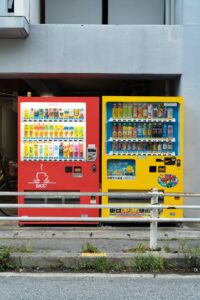- List the characteristics and flows of a distribution channel
- Understand what channel partners are and how they support distribution channels
- Understand what a wholesale intermediary is
- Recognize different types of retailers
- Understand the difference between supply chains and distribution channels
Channels of Distribution

As consumers, we take for granted that products will be available when we want to buy them. When we go to a supermarket the shelves will be filled with the products we want. When we are thirsty there will be a vending machine or convenience store around the corner. And we count on being able to get online and find any product available for purchase and delivery. Of course, there are actually hundreds of thousands of people who plan, organize, and labor long hours to make this convenience available.
With the growth of specialization, particularly industrial specialization, and with improvements in methods of transportation and communication, channels of distribution have become longer and more complex. Thus, corn grown in Illinois may be processed into corn chips in West Texas, which are then distributed throughout the United States. Or, turkeys raised in Virginia are sent to New York so that they can be shipped to supermarkets in Virginia. Channels do not always make sense.
The channel mechanism also operates for service products. In the case of medical care, the channel mechanism may consist of a local physician, specialists, hospitals, ambulances, laboratories, insurance companies, physical therapists, home care professionals, and so on. All of these individuals are interdependent and could not operate successfully without the cooperation and capabilities of all the others.
A distribution channel, also called a marketing channel, is a set of interdependent organizations involved in the process of making a product or service available for use or consumption, as well as providing a payment mechanism for the provider.
Distribution Channel Characteristics
- The channel consists of organizations, some under the control of the producer and some outside the producer’s control. All must be recognized, selected, and integrated into an efficient channel arrangement.
- The channel management process requires continuous monitoring and reappraisal. The channel operates twenty-four hours a day and exists in an environment where change is the norm.
- Channels should have certain distribution objectives guiding their activities. The structure and management of the marketing channel is thus, in part, a function of a firm’s distribution objective. It’s also a part of the marketing objectives, especially the need to make an acceptable profit. Channels usually represent the largest costs in marketing a product.
Channel Flows
One traditional framework that has been used to express the channel mechanism is the concept of flow. These flows reflect the many linkages that tie channel members and other agencies together in the distribution of goods and services. From the perspective of the channel manager, there are five important flows.
- Product flow: The physical movement of goods through the distribution channel. This includes the actual transportation, storage, and handling of products from the manufacturer through wholesalers and retailers until they reach the final consumer. For example, when a smartphone moves from a factory to a distribution center, then to a retail store, and finally to a customer.
- Promotion flow: The movement of persuasive marketing communications through the channel. This includes all activities designed to inform and convince customers to purchase products, such as advertising, sales promotions, discounts, and personal selling. For example, when a manufacturer creates advertising materials that retailers use to promote products to customers.
- Negotiation flow: The business arrangements and transactions that occur between channel members to facilitate product distribution. This includes activities like setting prices, determining delivery terms, and establishing payment conditions. For example, when a retailer negotiates purchase quantities and prices with a wholesaler.
- Ownership flow: The transfer of title or ownership rights as products move through the channel. This tracks how legal ownership of goods changes hands from manufacturer to wholesaler to retailer to final consumer. For example, when a customer purchases a product from a retail store, the ownership transfers from the retailer to the customer.
- Information flow: The sharing of data and feedback both upstream and downstream through the channel. This includes sharing sales data, customer preferences, inventory levels, and market trends among channel members. For example, when retailers provide manufacturers with data about which products are selling well or when manufacturers inform retailers about new product features.